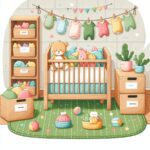Optimizing the nursery for sound sleep is a crucial element in ensuring your baby gets the rest they need for healthy development. This comprehensive guide will explore various strategies to create the ideal sleep environment for your little one, from controlling the nursery’s ambiance to selecting the right sleep aids.
Creating a Serene Nursery Atmosphere
The first step in optimizing the nursery for sound sleep involves creating a serene atmosphere that encourages relaxation. A calm environment is not just about aesthetics; it’s about crafting a space that soothes your baby’s senses and prepares them for slumber.
To achieve this, consider the nursery’s color scheme. Soft, muted colors such as pastel blues, greens, and pinks can have a calming effect on babies. Additionally, incorporating elements such as a comfortable crib mattress and blackout curtains can significantly enhance the sleep environment by providing physical comfort and darkness, which promote the release of melatonin, the sleep hormone.
Optimizing the Nursery for Sound Sleep Through Sound Management
Sound management is a critical aspect of optimizing the nursery for sound sleep. Babies are particularly sensitive to noise, which can easily disrupt their sleep. Implementing soundproofing measures or using white noise machines can help mask disruptive noises and create a consistent auditory environment conducive to sleep.
White noise machines are not just effective in drowning out external noises; they can also provide a soothing backdrop that mimics the sounds babies heard in the womb, offering additional comfort. However, the volume should be monitored to ensure it’s at a safe level, ideally below 50 decibels, to protect your baby’s hearing.
Integrating Sleep-Inducing Elements into the Nursery
Beyond aesthetics and sound management, integrating sleep-inducing elements into the nursery can significantly contribute to optimizing it for sound sleep. This includes choosing the right sleepwear, such as breathable fabrics that keep your baby at a comfortable temperature throughout the night, which can be found in guides like Choosing the Right Sleepwear for Your Baby’s Comfort.
In addition to sleepwear, incorporating a bedtime routine that may include reading from a selection of recommended bedtime stories for infants can signal to your baby that it’s time to wind down. The routine’s consistency is key, as it helps establish a sleep schedule that aligns with your baby’s natural circadian rhythms, further enticing them into a peaceful slumber.
Optimizing the nursery for sound sleep is an ongoing process that involves careful consideration of both the physical environment and the routines you establish. By focusing on creating a serene atmosphere, managing sound levels, and integrating sleep-inducing elements, you can significantly improve your baby’s sleep quality. Remember, each baby is unique, so it may take some experimentation with different strategies to find what works best for your little one.
Moreover, for those struggling with specific sleep challenges, exploring Dealing with Sleep Regression at 9 Months or Sleep Solutions for Babies with Colic can offer targeted advice and strategies to overcome common hurdles, ensuring every member of the family enjoys the rest they need and deserve.













